2015 Capstone Celebration Symposium
PLU Chemistry Department
April 27th to May 1st, 2015 Join the Chemistry Department to hear the senior capstone presentations. Student presentations will occur Monday through Friday. The schedule of talks with more details is given below. [ Monday | Tuesday | Wednesday | Thursday | Friday ] Keynote Speaker: David L. Coy (’90), Friday, 3:45 pm All talks in Morken Center, Room 103
Monday, April 27th , 2015 (Morken Room 103)
1:00 pm - Welcome
1:10 pm - Synthesis and Reactions of N-Heterocyclic Carbenes
Elizabeth Kaley, Senior Capstone Seminar
With the rapid industrialization and heavy reliance on fossil fuels the concentration of Carbon dioxide (CO2) in the Earth’s atmosphere has exponentially increased and continues to rise. CO2, due to its relative stability, is generally unreactive. In order to transform CO2 in to synthetically useful compounds it must be activated first. N-heterocyclic carbenes (NHCs) are effective organocatalysts used to activate carbon dioxide. The efforts to synthesize a stable NHC-carboxylate using 1,3-bis(2,4,6-trimethylphenyl)imidazole-2-ylidine are described within. It is hypothesized that this stable NHC-carboxylate can be transformed using tris(pentafluorophenyl)borane to other carbon compounds.
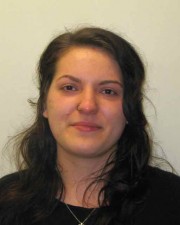
1:50 pm - The Synthesis of Functionalized Dicarboximide Diblock Copolymers and the Investigation of the Phase Diagram Using Wide Angle X-Ray Scattering and Optical Birefringence
Jesus Rosales, Senior Capstone Seminar
Solid polymer electrolytes are an alternative to Li-ion materials in battery construction. We synthesize functionalized diblock copolymer electrolytes and investigate their nanostructure. A 55% ethylene oxide diblock shows evidence of self-assembly. This morphology forms conductive regions connecting the electrodes, which could enhance battery performance.
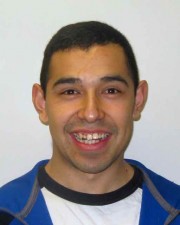
2:30 pm - Detection of Botryococcene Production in Escherichia coli via a Fluorescent Screen
Allen Chacko, Senior Capstone Seminar
The current study focuses on the detection of botryococcene, a branched triterpene biofuel produced by Botryococcus braunii algae. The unusual branched alkene nature of botryococcene renders it an effective precursor for production of several high octane fuels upon hydrocracking. Thus, there is interest in carrying out metabolic and protein engineering studies to optimize the production of botryococcene. In order to do this it would be useful to develop a screen to monitor production of branched alkenes such as botryococcene. In the current study a diaryltetrazole has been used due to its ability to selectively react with terminal alkenes to produce fluorogenic compounds. Prior research elucidated the genes (SSL1&3) necessary for botryococcene production which have been inserted into a dual expression vector and transformed into an E coli expression host. These E coli were cultured and exposed to the diaryltetrazole before being irradiated by UV to initiate the photoclick reaction between the diaryltetrazole and the terminal alkene. Cells with the SSL1&3 genes gave off detectable fluorescence while cells expressing squalene synthase and empty vectors did not.

3:10-3:20 - Break
3:20 pm - Effects of 3,5-dimethylphenylthiocarbamate on Optical Properties of CdSe Quantum Dots
Victoria Popovich, Senior Capstone Seminar
In this work, we explored effects of the 3,5-dimethylphenyldithiocarbamate (DMPTC) ligand on the optical properties of CdSe quantum dots (QDs). We found that ligand exchange with DMPTC causes redshifts in the excitonic absorbance peaks of the QDs, consistent with literature reports. Observed redshifts were consistent with increase of apparent size of particles due to the ligand shell. The percent change in size ranged over 2-4% for QDs with initial radii of 1.38-1.88 nm; the change was more significant for smaller crystals. QD photoluminescence (PL) was quenched upon ligand exchange. We did not observe any shifts in the QD PL energy or emission from trap sites after ligand exchange.
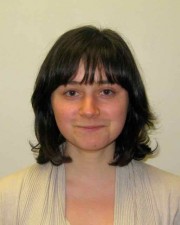
1:50 pm - Investigating the Effect Iron Oxide Deposition Time has on Porous Carbon Electrodes for the Development of Iron-Air Batteries
Gregor Uvila, Senior Capstone Seminar
New and improved battery technologies must be developed in order to meet the growing need to store energy from renewable energy sources. Porous carbon electrodes have shown promise in the development of batteries that have both higher energy densities and higher power densities than batteries that are currently available. Iron oxides can be deposited onto a porous carbon scaffolding to serve as the anode for the future development of Fe/Air batteries. Porous carbon electrodes deposited with iron oxide were designed, prepared and analyzed in the lab. Carbon nanofoams were constructed by soaking carbon fiber paper in resorcinol-formaldehyde solution, which polymerizes to form a highly porous network within the carbon fibers. The porous polymer was pyrolyzed in order to thermally decompose the oligomerized macromolecules into the charcoal scaffolding that supports the iron oxide. We deposited iron oxide from potassium ferrate onto carbon nanofoams, and studied the effect of the deposition time on the electrochemical behavior of the resulting electrodes. Cyclic voltammetry was used to identify the potentials at which the electrodes underwent oxidation and reduction. The carbon nanofoams and rust-coated carbon nanofoams were imaged using scanning electron microscopy (SEM). It was concluded that a deposition time of 20 hours leads to a decrease in the oxidation peak current relative to electrodes deposited for only 30 minutes. This result may be explained by the clogging of pores as deposition time was increased past 30 minutes. A deposition time of 30 minutes proved to show the most promise because there was an increase in oxidation peak and charge density seen in cyclic voltammetry and a retained porous network seen using SEM after iron oxide deposition.
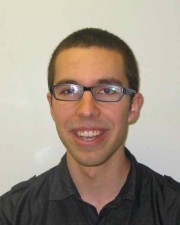
2:30 pm - Implications of Transcription on Adaptive Mutagenesis Using dst1 Knockout Cell Lines of S. cerevisiae
Jorge Velasquez, Senior Capstone Seminar
Drug resistance in cells has been of great interest because it can render certain treatments for diseases ineffective, presenting a major problem to modern medicine. Cells experiencing growth arrest due to drug selective pressure are capable of acquiring mutations that confer resistance via adaptive mutagenesis. Under such conditions, replication does not occur, but transcription must continue to provide proteins necessary for survival. To study the effects of transcription on adaptive mutagenesis in the yeast Saccharomyces cerevisiae, we generated a mutant cell line lacking the DST1 gene that encodes transcription factor IIS (TFIIS). Our experimental data indicated that this mutation contributed to an increase in the adaptive mutation frequency upon growth arrest by canavanine as compared to a control strain (dst1Δ: 2.54 x 10-7; wild type: 1.53 x 10-7). This increase was exacerbated in cell lines that also lacked OGG1, an enzyme responsible for base excision repair (BER) of the oxidative lesion 8-oxoguanine (dst1Δ ogg1Δ: 1.15 x 10-6; ogg1Δ: 5.34 x 10-7), indicating interactions between transcription and unrepaired DNA damage. These results have implications on the involvement of transcription in adaptive mutagenesis, a relationship worth further exploration.

3:10-3:20 - Break
3:20 pm - Developing Methodology for the Screening of ssDNA Aptamers Against Human Squalene Synthase
Cameron Dunn, Senior Capstone Seminar
DNA aptamers are short pieces of ssDNA or RNA that can bind to a target with great specificity due to their unique secondary structure. This can lead to the inhibition of enzymes by locking out highly flexible regions of the enzyme necessary for catalytic function. Our work this summer looked at developing screening methodology to isolate ssDNA aptamers that bind to human squalene synthase. Using an E. coli host, we transformed, expressed, and purified human squalene synthase for our aptamer studies.
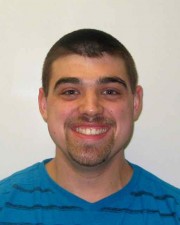
4:00 pm - Are You “Paraben Free”? Detection and Measurement of Parabens Used as Preservatives in Consumer Products
Allyson Swanstrom, Senior Capstone Seminar
Parabens, esters of para-hydroxybenzoic acid, and their biological effects have been a topic of concern in recent media reports and product marketing campaigns. Structurally, parabens resemble estrogen, which raises the worry of how these chemicals react with the aspects of the endocrine and reproductive systems. A variety of studies have been conducted which reveal differing concentrations of parabens are present in the human body. Using solid-phase extraction of human urine, isotope dilution-high-performance liquid chromatography and tandem mass spectrometry, a urine analysis study revealed that the majority of the individuals in the experiment cohort did test positive for parabens. In an experiment on rats, exposure to a dose of 1.00% propylparaben caused a 36.4% decrease in testosterone levels when compared to a control group. The lack of alternative compounds along with the effectiveness and low cost of parabens makes them remain as the most desirable preservative but more studies must be carried out to assess the safety of the chemical structures.
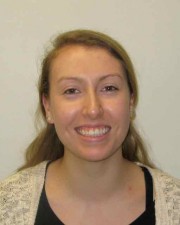
1:10 pm - Maximizing the Survival of Saccharomyces cerevisiae Under Selective Pressure
Pannapat Angkanaworakul , Senior Capstone Seminar
Drug resistance in microorganisms can occur when an organism acquires a mutation upon exposure to a selective pressure causing the cells to grow out of an arrested state, a process called adaptive mutagenesis. Using Saccharomyces cerevisiae, as a model organism, we investigated the replicational mutation rates and adaptive mutation frequencies of wild type and ogg1Δ cell lines upon exposure to canavanine. The results show both the replicational mutation rate and adaptive mutation frequencies of ogg1Δ are higher (1.49 x 10-6; 5.43 x 10-7) compared to wild type (4.18 x 10-7; 1.53 x 10-7) due to its inability to repair oxidative damage. Additionally, we assessed survival of cells in the presence of canavanine and are working to identify the optimal conditions for selective pressure that will yield the highest percent survival while the cells are under growth arrest, anticipating that longer survival would allow the cells more opportunity to generate an adaptive mutation.

1:50 pm - Porous Iron Oxide Electrodes on a Carbon Nanofoam Scaffold
Max Mayther, Capstone Senior Seminar
Surface area of the electrode is increased through a carbon nanofoam (CNF) scaffold to increase the power of metal-air batteries, We describe the successful creation of aperiodic macroporous CNF (5-20 μm) creating a rapidly accessible surface area of hundreds of square meters per gram. Upon the electroless deposition of iron oxide on CNFs, the effect was assessed through scanning electron microscopy, impedance spectroscopy, cyclic voltammetry, and galvanostatic testing. Being redox active, the created electrodes are able to discharge at 10 A/g and produce 360 ± 12 W/kg. The greatest amount of electrochemical capacity was achieved through electronic contact of the bare CNF rather than through contact with FeOx. Despite this increase, capacity is extremely variable (84.3 ±44.8 mAh g-1) and sees reduction of nearly 50% after 10 cyclic voltammetry cycles as a possible result of aperiodic pore structure and solubility in electrolyte.

2:30 pm - Optimizing the Ene Reactions of Nitroso enophiles
Aiste Taylor, Capstone Senior Seminar
The ene reaction occurs when an alkene and a reactive enophile come together under optimal environment conditions. Current ways of performing such a reaction involve a great deal of time and can be difficult. We have looked at how nitroso compounds can be used as enophiles in order to optimize this type of reaction. Copper and selenide catalysts were employed in the oxidation of an N-hydroxyurea and p-chloroaniline, respectively. Variables such as temperature, time, solvents, and enophile structure were screened. We found that temperature had no considerable effect on the reaction rate, time only allowed the reaction to proceed further to a certain point, the enophiles used all performed at a similar rate, and the solvent was critical in minimizing competitive side reactions.

3:10-3:20 - Break
3:20 pm - Synthesis and Characterization of Novel Ethylene Oxide Functionalized Oxanorbornene Dicarboximide Monomers and Polymers for Use as a Lithium-Ion Electrolyte Support
Doug Smith, Capstone Senior Seminar
The syntheses and characterization of novel, ethylene oxide functionalized oxanorbornene dicarboximide monomers and polymers are reported. Ethylene oxide (EO) side chains were of lengths n = 8, 12. Polymers were synthesized via the ring-opening metathesis polymerization (ROMP). The synthesized materials were then characterized with 1H NMR and GPC. The polymers were doped with LiTFSI and impedance spectroscopy measurements were performed to analyze the relationship of ionic conductivity to the segmental dynamics of the rigid polymer backbone.
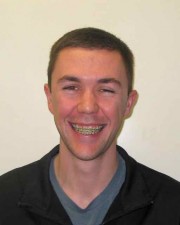
1:50 pm - Building a Molybdenum Complex: Working Towards an Organometallic Approach to Activating Carbon Dioxide
Kathleen Berge, Capstone Senior Seminar
An optimized synthesis of a transition metal tris(pyrazolyl)borate complex capable of activating carbon dioxide was investigated. The relatively inexpensive transition metal molybdenum was selected due to its widespread use in the activation of small molecules, such as CO2 and N2. The reaction of the tridendate tris(pyrazolyl)borate ligand (Tp) with molybdenum hexacarbonyl gives control over three of the molybdenum center’s coordination sites, but the resulting [TpMo(CO)3]– anion is not air stable. To stabilize the [TpMo(CO)3]– anion in air and further enhance its reactivity it was reacted with p-tolylsulfonylmethylnitrosamide, commercially available as Diazald®, to prepare the air-stable, neutral dicarbonylnitrosyl[tris(pyrazolyl)borato]molybdenum complex, TpMo(CO)2NO. Making alterations to the temperature, molar ratios between reactants and reflux durations of the TpMo(CO)2NO synthesis has greatly decreased the amount of time for this synthesis compared to reported procedures, reducing the time from over 24 hours to less than 8 hours with a 42% yield. That synthesis will be described herein, and compared to traditional methods in terms of time, stoichiometry, purification, and yield. Additionally, the potential for further improvements using photochemistry will be discussed. After further optimization of the synthesis, the activation of CO2 by this complex, or its hydride analogues, will be studied with the goal of reducing CO2 to useful compounds.

2:30 pm - A New Strategy for Drug Release: Sulfonamides as Drug-Polymer Conjugates
Christopher Erkkila, Capstone Senior Seminar
It has been observed that the retro-Diels-Alder reactions of adducts formed from nitroso compounds occur at much lower temperatures compared to typical all-carbon Diels-Alder adducts. The synthesis of 3,6-dihydro-1,2-oxazines using dienes and nitrosocarbamide dienophiles has allowed our laboratory to study the rate of the retro-hetero-Diels-Alder reaction as a function of diene structure. These compounds decompose at a controlled rate and have applications in the thermally-triggered, time-controlled delivery of pharmaceuticals. The nitroso dienophile formed by the oxidation of N-p-toluenesulfonyl-N′- hydroxyurea has been successfully employed to form a model system for sulfonamide-bearing drug-polymer conjugates. Release of p-toluenesulfonamide is triggered by a rate-determining retro-Diels-Alder reaction with subsequent hydrolysis steps. Initial 1H-NMR rate studies have indicated favorable rates of decomposition at mild temperatures (25-60 ˚C) for the adducts formed with cyclopentadienes and 1,3-cyclohexadienes.
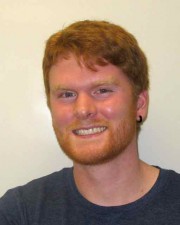
3:10-3:20 - Break
3:20 pm - Fitness to Drive After the Use of Cannabis: Developing a Standardized Method
Taryn Dee, Capstone Senior Seminar
Abstract coming soon!

1:10 pm - Porous Carbon as Scaffolding for Iron-air Electrodes
Sean Murphy, Senior Capstone Seminar
Metal-air batteries exhibit promising energy storage for future applications in electronics and electric car industries, but currently do not provide enough power for practical use. Our electrode was created by using a macroporous carbon scaffold for iron oxide that was deposited from a 25 mM potassium ferrate solution. We hypothesized that an increase in surface area would allow more electrochemical reactions to occur, resulting in a higher power output. The iron-air electrodes can provide a power of up to 360±12 W kg-1 of FeOx, discharged at 2 Å, and are capable of discharging at 10 Å for 20 s. With an average energy of 155±37 Wh kg-1 of FeOx, this is less than half of the energy of zinc-oxide batteries currently in production. Our electrodes do not account for the entire mass of a battery, which means the power and energy values are even lower than the current data suggests in comparison to batteries. This means we are not accessing as much of the FeOx as we originally intended. The samples also lose >50% of their electrochemical capacity after 10 cycles due to either the loss of electrode mass during cycling or an altered surface morphology, which could reduce redox activity.
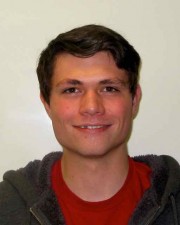
1:50 pm - In silico Screening of Highly Functionalized Benzofulvenes as Competitive Inhibitors of Human Thioredoxin Reductase 1
Drew Huff, Senior Capstone Seminar
The goal of our work is to explore several small molecules as possible inhibitors of Human Thioredoxin Reductase 1 (TrxR1). TrxR1 inhibition has been shown to induce tumor cell apoptosis and prevent metastasis. We aim to develop a library of compound leads and better understand the chemical nature of the protein-ligand docking interaction for the future development of potential therapeutics against TrxR1. Computational modeling with AutoDock Vina was employed to determine the docking affinity potential of a series of fulvene-based small molecule ligands. The structural activity relationships of highly functionalized benzofulvene compounds revealed several ligands with excellent in-silico affinity, a few examples have even produced nanomolar binding affinity. Current work has transitioned into producing a full synthetic library and in-vitro testing.

2:30-3:30 pm - Division of Natural Sciences Poster Session (Morken Atrium)
3:30-3:45 - Break
3:45 pm - Keynote Speaker (Morken 103):
Medical Imaging: Progress towards early diagnosis, minimal invasive therapies, and personalized treatment.
David L. Coy (’90), MD PhD
Department of Radiology, Digestive Disease Institute & Cancer Institute, Virginia Mason Medical Center; Affiliate Assistant Professor of Radiology, University of Washington
Since the first use of X-rays to produce anatomic radiographs over 100 years ago, medical imaging has developed into an essential tool for the diagnosis of human disease. Over the past two decades advances in biochemistry, physiology, genetics, physics, and engineering have converged to produce detailed anatomic and functional, physiologic imaging of disease at increasingly greater levels of detail and specificity. The advancements in medical imaging are leading to earlier detection of disease, when many disease are usually more easily treated and there is greater chance for cure; development of minimally invasive image-guided therapies that are effective but with much less morbidity and debilitation than caused by traditional treatments and conventional surgery; and improved optimization and personalization of treatment.
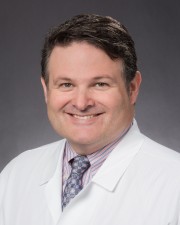



Social Media